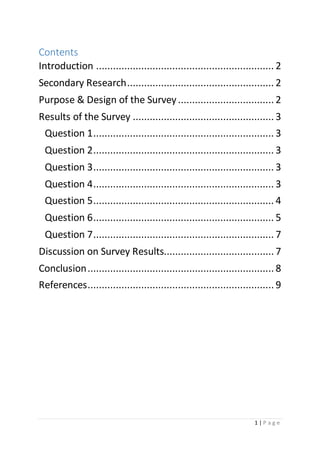
Migration
- 1. 1 | P a g e Contents Introduction ............................................................... 2 Secondary Research.................................................... 2 Purpose & Design of the Survey.................................. 2 Results of the Survey .................................................. 3 Question 1................................................................ 3 Question 2................................................................ 3 Question 3................................................................ 3 Question 4................................................................ 3 Question 5................................................................ 4 Question 6................................................................ 5 Question 7................................................................ 7 Discussion on Survey Results....................................... 7 Conclusion.................................................................. 8 References.................................................................. 9
- 2. 2 | P a g e Report on Student Migration Patterns Introduction Migration,as itrelatestothisreport,may be definedasthe movementof people toanew area or country, inorder to findworkor betterlivingconditions(Oxforddictionary).There are many differenttypesof migration, andstudentmigration formsaverylarge aspectof it. The purpose of thisreportis to analyse researchdone onmigration,anddraw conclusionsbasedonthisresearch. Thisreportis divided intofourmain parts,firstlysecondary researchrelatingtomigrationbasedon previousresearch,secondlyexaminingthe purpose anddesignof the survey,the thirdpointis analysingthe resultsgatheredfromthe surveyandfinallyadiscussionof the resultsof the survey. Accordingto data fromUNESCO,in 1996, 1.6 milliontertiarylevelstudentswere studyingabroad,an increase of about250,000 studentswhencomparedwithresultsfromfive yearsprior(King&Ruiz- Gelices2003, p.232). In an article titled:“Policyoptionsformanaginginternational student migration:the sendingcountry’sperspective”Gribble (2008,p.26) notesthat certaincontributory factors forthe suddenrise ininternationalstudentmigrationinclude,inadequateuniversityplaces, mainlybecause emergingeconomieshave beenunable tomeetthe demandfortertiaryeducation. Anotherfactorbeingthat families andstudents expectthatstudywill enablethemgainprofessional and businessadvantages(Cate Gribble2008, p. 26). Secondary Research Howeverwhile itisoftenbeneficialtothe hostcountryof these studentmigrants,inthat itboosts bothfinancial andeconomicinstitutions,the same cannotbe saidaboutcountrieswhose students studyabroad.Accordingto McGill (2013, p.168): “Academicmigrationraisespertinent questions regardingthe causesand effectsof sucha significantdemographicmovementof highlyskilled individuals.”Studentsinthe longtermleavingtheirhome countriestostudyabroadand ultimately not returninghome uponthe completionof theirstudentscouldleadtoa braindrainintheirhome countries. Purpose & Design of the Survey The purpose of the surveywasto findmore informationaboutmigrants. The Instrumentusedfor thissurveyisSurveymonkeywhichisanonline survey.A range of sevendifferentquestionswere usedto collectdata. Howeveronreflection,itwouldhave beenbettertohave afew more questions inorder to gaina widervarietyof information.
- 3. 3 | P a g e Results of the Survey The followingare the resultsof the surveyconducted (pleasenote thatone individualskippedall questions): Question 1 The firstquestionwasan inquiryasto the genderof the respondents,Genderbasedquestionsare commonon surveys.The resultsshowthatoutof the 12 respondents,7of them, accountingfor 58.33% were female,whereas5of them(41.67%) were female. Question 2 The second questionwasinquiringthe age of the correspondentsthe age bracketswere 16-24, 25- 34, 35-44, and 45-74. It isinterestingtonote thatall respondentstothisquestion were withinthe agesof 16 – 24. Question 3 The third questiononthe survey,wasto see people’sunderstandingof whatmigrationis.Three optionswere given:“people Move toanothercountry”,“people immigratetoanothercountry”and finally“people seekforaplace in othercountry”.Outof the 12 respondents,9(75%) picked“people Move to anothercountry”,3 (25%) picked“people seekforaplace inothercountry” Question 4 The fourthquestionwasinregardsto the type of migrantthe respondentis,withatotal of 11 respondents beingstudentmigrants,whereasonlyone respondentwas arefugee.
- 4. 4 | P a g e Question 5 The fifthquestionwasonthe respondent’spreferredcountryof migration.Five countrieswere scored,whichwere;China,America,Australia,CanadaandKorea.Americahadthe highestscore of 4.17. Figure 1 is an overview of the resultstoquestion5. Figure 1: Preferred countries for migration.
- 5. 5 | P a g e Question 6 Thisquestion,required respondentstostate theirreasonforfuture migrations.Theirresponsesare showinFigure 2. Figure 2: Various responses given to the question “What will your main reason be for migrating in the future?”
- 6. 6 | P a g e
- 7. 7 | P a g e Question 7 Thisquestionrequiredrespondentstochoose the country,whichtheywouldliketovisitinthe future. 10 countriesandone continent(Africa) were tobe chosenfrom, only6countries,the United Arab Emirates,China,France,the UnitedKingdom,AmericaandCanadahad responses.Netherlands, India,Switzerland,Russiaandthe continentof Africa,didnotgetanyresponses.The United Kingdomhadthe highestwith4 respondents. Discussion on Survey Results From the surveyresults,itiscanbe concludedthatmajorityof people dounderstandwhat migrationis,andknowwhatclass of migranttheyfall into.Thoughonlytwocategoriesof migrants (refugee andstudent)receivedaresponse.Perhapsinthe future,surveyssuchasthese shouldbe conductedindifferent geographical locations,inordertogeta widerrange of results. It isalso safe toestablishthata large numberof the respondentsare studentmigrants,andthat studentmigrationisindeednumericallyandstrategicallyimportantaspectof population(King& Ruiz-Gelices2003, p.229). Thoughthere isno correlationbetweengenderandstudentmigration, certainaspectsof the reportcorrelatedwithpreviousstudies.Allof the respondentswere withinthe agesof 16-24 and 91.67% were studentmigrants,thoughthisresultisexpectwhenthe surveyis conductedwithinauniversityenvironment,howeveritdoesprove thata large numberof migrants are studentmigrants.Asof 1996 indicationsfromUNESCOdatashowedthatof the 1.6 million tertiarystudentsthatwere studyingabroad,Australiaaccommodatesabout7% (justovera hundred thousand) of these tertiarylevel students (King&Ruiz-Gelices2003, p.232). The fact that 11 out of 12 respondentswere student migrantsisindicativeof the large numberof studentmigrantsin Australia. Anotheraspectof the surveywhichshouldbe analysedisthe preferredcountryof migration (question5). Respondentswereaskedtorankcountrieswhichtheywouldlike tomigrate tofrom highesttolowest,the countrieswere:China,America,Australia,CanadaandKorea.Outthe five countriesAmericahadthe highestscore of 4.17. Thisisinterestingtonote asit correlateswiththe educational database of OECDwhichshowsthatout of all destinationcountries,the UnitedStatesof Americawasrankedfirstwith31% of all the studentsenrolledabroadstudyinginAmerica(Bessey 2010, p.346). The reasonfor thiscouldbe relatedtothe subsequent question,whichaskswhat mightbe the reasonforfuture migration.Mostof the responseswere alongthe linesof “betterlife”, “betterenvironment”,“study”andsoon. Lu, Zong & Schissel (citedinMcGill 2013, p.346) state that the intentionsof migrationare usuallythe focusasoppose toactual outcomes.Mostmigrants
- 8. 8 | P a g e intendongettingabetterlife oreducation,anditis nosurprise thatAmericaisthe top choice,being the foremosteconomicandglobal superpower. It isalso interestingtonote thatthe UnitedStateswas notthe top answerfor question7,which askedwhatcountry the respondentswouldliketovisitinfuture.The topanswerhere wasthe UnitedKingdomwith 4votes,France with3 votesandthe UnitedStates had 2 votes.There couldbe a numberof speculatorreasonsasto why the UnitedKingdomwasthe topanswer,perhapsithasa more favourable environmenttothe UnitedStatesinthe opinionof the respondents,oritwasa bettertouristdestination. It isalso worthyof note that while majorityof the respondentswere studentmigrants,one wasa refugee.Since the endof WorldWarII, Australiahasmade substantial contributionstothe resettlementof the world’srefugees(Price 1986, p.81). Conclusion In conclusion,this reportsoughttoexamine migration withaprimaryfocusonstudentmigration, usingsurveyresultsaswell asinformationgatheredfromvariousresearcharticles.Student migrationisa verylarge formof migration,howevernotenoughresearchhasbeenfocusedonit. Resultsfromalmostall participantsshow clearlythe importance of studentmigration.While itmay be arguedthat the environmentinwhichthe surveywasconductedispartlyresponsible forthis result,studentmigrationcannotbe overlooked.
- 9. 9 | P a g e References Bessey,D.2010, ‘International StudentMigrationtoGermany’, EmpiricalEconomics,Vol.42, No.1, pp.345-361. Gribble,C.2008, ‘PolicyOptionsforManagingInternational StudentMigration:The Sending Country’sPerspective’,Journal of HigherEducationPolicyandManagement,Vol.30,No.1, pp.25-39. King,R. & Ruiz-Gelices,‘InternationalStudentMigrationandthe European‘YearAbroad’:Effectson EuropeanIdentityandSubsequentMigrationBehaviour’, InternationalJournalof Population Geography,Vol.9,No.1, pp. 229-252. McGill,J. 2013, ‘International StudentMigration:OutcomesandImplications’, Journalof InternationalStudents,Vol.3,No.2, pp. 167-181. OxfordDictionary,viewed3August2015, <http://www.oxforddictionaries.com/definition/english/migration>. Price,C.A.1986, ‘RefugeesandMassMigration:Australia’, InternationalMigration Review,Vol.20, No.1, pp.81-86